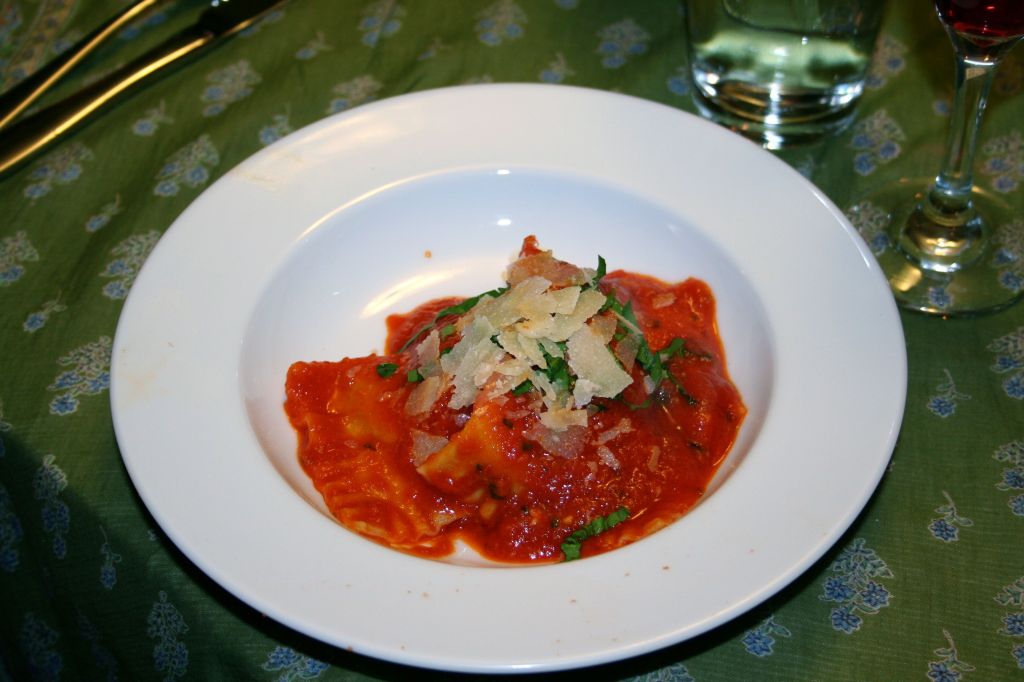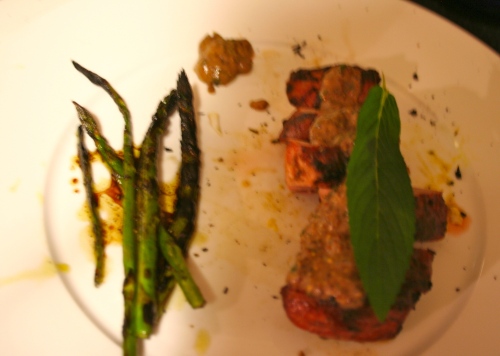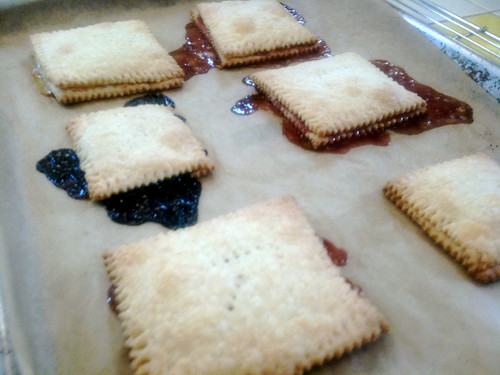 I’m not quite sure where I first ran into Brad Greenhill, but I do know Shana introduced us. In the period of recovery from my accident, I was struck by the idea that I wanted to throw a big thank you dinner for the many really wonderful friends who had helped me through the roughest period and Shana said she’d like to cohost and (bright girl) “we should get my friend Brad to cook. He’s doing some of the best cooking in town.” Sold! Next thing I knew, we were chatting over my dining room table, talking plates and counting vegetarians. And then next thing I know, Brad was standing in my kitchen on a Saturday night, calm and collected and turning out a miracle of a dinner for 18 people. Ok, there may have been a drop or two of sweat on his brow but in spite of that he produced CARROT SOUP with hazlenut, nigella, yogurt, and mint,CECI BEANS dressed with sesame, jalepeno, meyer lemon, scallion, and OMG RAVIOLI short rib, rojo (Brad’s patented red sauce), fiore sardo and basil and DEVIL’S CHICKEN aleppo (shown, in all its glory, above), salsa verde, warm bread salad and OLIVE OIL CAKE with a citrus glaze. The guests were generous in bringing wine, and there was good food and friendly conversation until all hours, and though I felt there was little I could do to repay the amazing generosity of my friends during my time of need, I ended up feeling like dinner by Brad was a pretty good start. Love and a fuly laden table . . . they do go together, don’t they?
I’m not quite sure where I first ran into Brad Greenhill, but I do know Shana introduced us. In the period of recovery from my accident, I was struck by the idea that I wanted to throw a big thank you dinner for the many really wonderful friends who had helped me through the roughest period and Shana said she’d like to cohost and (bright girl) “we should get my friend Brad to cook. He’s doing some of the best cooking in town.” Sold! Next thing I knew, we were chatting over my dining room table, talking plates and counting vegetarians. And then next thing I know, Brad was standing in my kitchen on a Saturday night, calm and collected and turning out a miracle of a dinner for 18 people. Ok, there may have been a drop or two of sweat on his brow but in spite of that he produced CARROT SOUP with hazlenut, nigella, yogurt, and mint,CECI BEANS dressed with sesame, jalepeno, meyer lemon, scallion, and OMG RAVIOLI short rib, rojo (Brad’s patented red sauce), fiore sardo and basil and DEVIL’S CHICKEN aleppo (shown, in all its glory, above), salsa verde, warm bread salad and OLIVE OIL CAKE with a citrus glaze. The guests were generous in bringing wine, and there was good food and friendly conversation until all hours, and though I felt there was little I could do to repay the amazing generosity of my friends during my time of need, I ended up feeling like dinner by Brad was a pretty good start. Love and a fuly laden table . . . they do go together, don’t they?
Since that first meal, I’ve made a small hobby of stalking Brad’s cooking. and luckily he hasn’t made it or himself hard to find. He’s been doing “Pop-up” dinners around town, located in some interesting venues and full of small and tasty surprises. You can find out about them at his website, (one coming up soon at the late. lamented Jefferson Market)where he is also kind enough to share a few recipes including one for that trademark rojo
We joined several friends at his Jefferson Market dinner in April, where we ate:
SAIGON TOAST
pig face pâté, pickled roots, sriracha aioli, cilantro
63° QUAIL EGG
fiddleheads, pea tendrils, anchovy
CHARRED CARROTS
green garlic, aleppo, lemon oil, crumbs
RABBIT RILLETTE
apple, celery root, hay, ‘shrooms
SHEEP’S ASS GNOCCHI
ewe’s milk, ramps, black pepper
PORCHETTA
braised coronas, arugula, lemon, horseradish
PETIT GATEAU
salt caramel, brown butter, sage
a perk of patronizing Brad’s dinners is that he’s doing some nice work with other local businesses. He sources wine from Everyday wine and attractive floral decorations from Pot and Box, and of course he’s giving exposure to those venues like Braun Court and The Jefferson Market. Eat good food and dsupport our local folks at the same time. Bonus!
 In an email chat bout his start in cooking, Brad reminisced a bit about his time in Boston and then said “After about two years there I began getting burned out and queestioned whether or not I wanted to be or am a chef. I felt a bit of pressure, be it societal or how I was brought up that i needed to be more than that in life. In those days being a cook / chef didn’t have the “cool” cultural cache and level of career acceptance it does now. . . . right about that time books like Soul of the Chef, Kitchen Confidential and the Food Network started to bloom. Anyway I left the business and started my current web business. I vowed one day I’d be back but on my own terms and with my own restaurant / bar, which is something I’ve wanted to have since I was in college.” Me. I’m glad those questions had an answer that led to my eating Brad’s food, and I kinda hope the restaurant works out in Ann rbor, so I get to keep doing so.
In an email chat bout his start in cooking, Brad reminisced a bit about his time in Boston and then said “After about two years there I began getting burned out and queestioned whether or not I wanted to be or am a chef. I felt a bit of pressure, be it societal or how I was brought up that i needed to be more than that in life. In those days being a cook / chef didn’t have the “cool” cultural cache and level of career acceptance it does now. . . . right about that time books like Soul of the Chef, Kitchen Confidential and the Food Network started to bloom. Anyway I left the business and started my current web business. I vowed one day I’d be back but on my own terms and with my own restaurant / bar, which is something I’ve wanted to have since I was in college.” Me. I’m glad those questions had an answer that led to my eating Brad’s food, and I kinda hope the restaurant works out in Ann rbor, so I get to keep doing so.
.








 Sometimes I overestimate my talents, my improvisational flare, my ability to combine a few fine ingredients with a little je ne sais quoi and produce something that can be quite respectably called dinner. One night a couple of weeks ago, I found myself alone with young Nick with dinner coming on and not a menu plan in site. So I parked the boy in front of a bowl of butter noodles and peas, poured myself a gin and tonic and rummaged in the fridge.
Sometimes I overestimate my talents, my improvisational flare, my ability to combine a few fine ingredients with a little je ne sais quoi and produce something that can be quite respectably called dinner. One night a couple of weeks ago, I found myself alone with young Nick with dinner coming on and not a menu plan in site. So I parked the boy in front of a bowl of butter noodles and peas, poured myself a gin and tonic and rummaged in the fridge.











